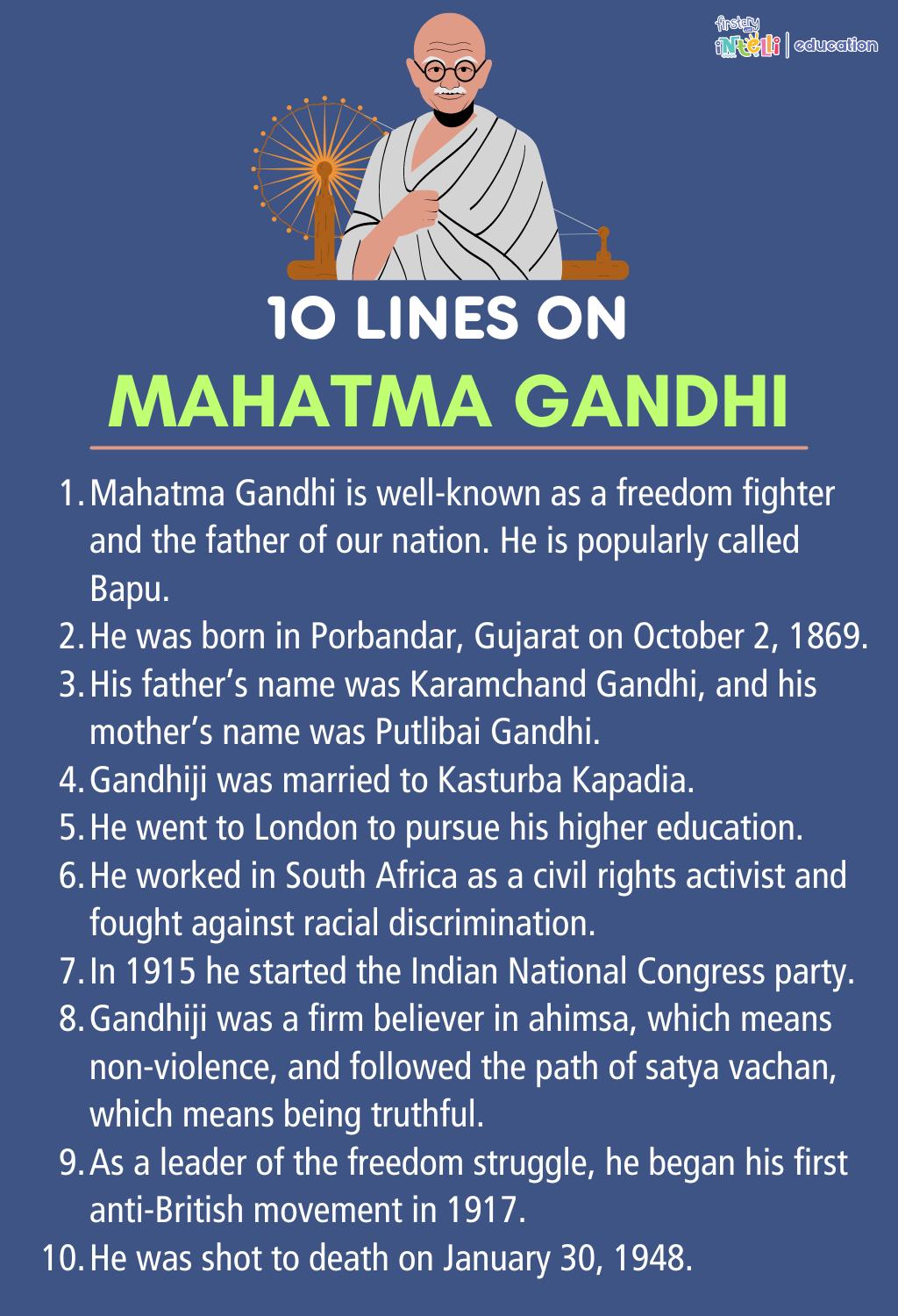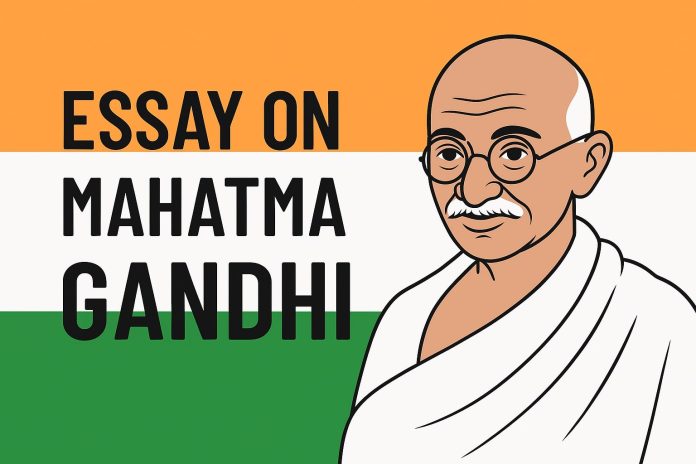- Key Points To Remember When Writing An Essay On Mahatma Gandhi
- 5 Lines on Mahatma Gandhi
- 10 Lines on Mahatma Gandhi
- Paragraph On Mahatma Gandhi
- Essay On Mahatma Gandhi In 200 words
- Mahatma Gandhi Essay In English In 300 Words
- Mahatma Gandhi Essay In English In 500 Words
- What Will Your Child Learn From An Essay On Mahatma Gandhi?
- Interesting Facts About Mahatma Gandhi For Kids
- FAQs
Mahatma Gandhi is a famous historical figure. He is known as the father of our nation and is well-regarded by all the country’s citizens and people worldwide. Most Indian children are familiar with Mahatma Gandhi, also known as Gandhiji, and learn about his contributions to the Indian freedom struggle in school. Students may be asked to write an essay on Gandhiji as a class exercise, for a test, or for a competition.
For this assignment, they must learn and remember facts about his life and his role in India’s fight for independence. Writing a Mahatma Gandhi essay in English may sound challenging for some children, but with guidance, they will be able to write this essay independently. Here is an essay on Mahatma Gandhi for classes 1, 2 and 3 that will help school children with their assignments.
Thank you for reading this post, don't forget to subscribe!
Key Points To Remember When Writing An Essay On Mahatma Gandhi
The essay about Mahatma Gandhi is slightly different from essays on general topics. Children need to remember accurate facts and weave a good narrative for these kinds of topics. If you are tasked with writing a Mahatma Gandhi essay in English, the following is for you. Here are some essential points to remember:
- Before writing the essay about Mahatma Gandhi, it is essential to accurately recall facts such as names, places, events, and dates.
- For a concise Mahatma Gandhi biography, stick to facts about Gandhi and avoid delving too deeply into specific topics.
- For longer essays, begin the introduction by discussing the importance of the man in Indian history.
- Discuss his early life, work, and transition to Gandhiji’s ideology.
- Finally, conclude the essay on Gandhi by discussing his impact on the nation and the inspiration he provided to people.
5 Lines on Mahatma Gandhi
Mahatma Gandhi, a beacon of peace and non-violence, played a pivotal role in India’s struggle for independence, inspiring countless generations. In just five lines on Mahatma Gandhi for classes 1 & 2, students can learn about his remarkable life and values, making it a perfect starting point for a simple essay on the subject.
- Mahatma Gandhi was born on October 2, 1869, in India and is known as a great leader.
- He taught people to be kind and to resolve problems without resorting to violence.
- Gandhi wanted India to be free from British rule, so he chose non-violence and led peaceful marches.
- One famous march was the Salt March, during which he walked a long distance to collect salt from the sea.
- Gandhi’s ideas of peace and love continue to inspire people today.
10 Lines on Mahatma Gandhi
Children of lower primary classes may be asked to write some lines on Mahatma Gandhi to build a foundation for essay writing. This can be done by writing ten lines about Mahatma Gandhi. Below are the top ten factual lines about Mahatma Gandhi that will help you write a perfect essay for classes 1, 2, and 3:
- Mahatma Gandhi is well-known as a freedom fighter and the father of our nation. He is popularly called Bapu.
- He was born in Porbandar, Gujarat, on October 2, 1869.
- His father’s name was Karamchand Gandhi, and his mother’s name was Putlibai Gandhi.
- Gandhiji was married to Kasturba Kapadia.
- He went to London to pursue his higher education.
- He worked in South Africa as a civil rights activist, fighting against racial discrimination.
- In 1915, he started the Indian National Congress party.
- Gandhiji was a firm believer in ahimsa, which means non-violence, and followed the path of ‘satya vachan,’ which means being truthful.
- As a leader of the freedom struggle, he began his first anti-British movement in 1917.
- He was shot to death on January 30, 1948.

Paragraph On Mahatma Gandhi
Before writing longer essays, we should practice writing a paragraph on Mahatma Gandhi in 100 words. Here’s a short paragraph on Mahatma Gandhi to aid that. Let’s look at the paragraph on this national personality.
Mahatma Gandhi, born October 2, 1869, in Porbandar, India, is one of India’s most iconic historical figures. He has several monikers, such as ‘the Father of the Nation’, ‘Bapu’, ‘Mahatma’, ‘Rashtrapita‘, and many more. Gandhiji is renowned for his philosophy of non-violence (Ahimsa) and civil disobedience. He is also known for his simplicity, truthfulness, and dedication to social justice. Lakhs of people joined Mahatma Gandhi in his journey to free India from colonial rule. He and his supporters organised movements like the Dandi March (also known as the Salt March) and the Quit India Movement, which eventually led to India’s independence in 1947. He was assassinated on January 30, 1948, but his principles and message endure as a beacon of hope and unity.
Essay On Mahatma Gandhi In 200 words
When asked to write a short essay on Mahatma Gandhi, students can list the highlights they remember about Gandhiji’s life and weave them into a paragraph. Here is a sample essay on Mahatma Gandhi in 150 to 200 words:
Mohandas Karamchand Gandhi is one of the most popular historical figures in the nation. He was born in Porbandar, Gujarat, on October 2, 1869. His family was affluent, and he had a good reputation as a quiet-natured boy. He went to London for his higher education, where he studied law and became a Barrister. Upon his return to India, he practised law at the Bombay High Court.
Gandhiji later moved to South Africa to work, but soon lost interest in law. Instead, he joined hands with the natives there to start satyagraha—a non-violent protest against the oppression of Europeans. He soon returned to India and joined the struggle for independence from British rule.
He was a simple man who taught the people of India the virtues of simplicity and self-reliance. He encouraged them to boycott foreign goods and make their Swadeshi goods. He was loved and respected by people of all communities.
As a freedom fighter, Gandhi was a man of firm conviction. During his freedom struggle, the British had put him in jail several times, where he endured extreme hardships. To honour his role in the freedom struggle, his birthday is a national holiday to pay homage to him and everyone who stood with him.
Mahatma Gandhi Essay In English In 300 Words
This essay on Gandhi provides a concise yet comprehensive overview of his life, teachings, and role in India’s struggle for independence. Ideal for students seeking to understand the legacy of the Father of the Nation in simple English.
Mahatma Gandhi, born on 2nd October 1869 in Porbandar, Gujarat, is honoured as the Father of the Nation in India. He devoted his entire life to fighting for India’s independence from British rule through non-violent methods. Gandhi’s philosophy of truth, non-violence, and peaceful protest inspired millions and formed the backbone of the Indian freedom struggle.
After completing his law education in England, Gandhi experienced racial discrimination in South Africa. This injustice motivated him to campaign for the rights of the Indian community there, using peaceful protests and civil disobedience. Gandhi’s method of peaceful resistance, known as Satyagraha, emphasised truth and non-violence as powerful tools for social change.
Returning to India in 1915, he became the leader of the independence movement, organising several key campaigns, including the Champaran Satyagraha, the Non-Cooperation Movement, the Salt March, and the Quit India Movement. These movements united Indians across different religions, castes, and regions in the collective fight for freedom.
Gandhi was also dedicated to social reform. He fought against untouchability and worked tirelessly to improve the lives of the poor and oppressed. He encouraged Indians to become self-reliant by embracing khadi, the homespun cloth, as a symbol of national pride and economic independence. Gandhi’s simple way of living—wearing khadi, practising vegetarianism, and embracing minimalism—showed his deep connection to the people.
Mahatma Gandhi’s birthday, 2nd October, is observed as Gandhi Jayanti, a national holiday in India, as well as the International Day of Non-Violence. Though he was nominated for the Nobel Peace Prize five times, he never received it. His teachings have influenced many global leaders, including Nelson Mandela.
Today, his principles continue to resonate in various movements worldwide, encouraging individuals to stand against oppression and injustice. Through education and dialogue, Gandhi’s approach remains relevant, urging us to seek harmony in a diverse and often divided world.
Mahatma Gandhi Essay In English In 500 Words
A long essay on Gandhi requires students to know and remember several details about his life and write them with a good narrative. Writing a long essay on Mahatma Gandhi is not difficult. Here is a sample essay for class 3 students on Mahatma Gandhi:
Mohandas Karamchand Gandhi, also known as Mahatma Gandhi, is often referred to as the “Father of the Nation.” He was a freedom fighter, national leader, and social reformer who worked tirelessly to achieve India’s independence. Famous poet Rabindranath Tagore gave him the title of Mahatma. In Sanskrit, ‘Mahatma’ means ‘Great Soul’. He was given this name for his non-violent approach to the freedom movement, contributions to social reform, and convictions to lead a simple life. Since his time, Gandhiji and his philosophy have inspired all social reform movements.
Birth And Childhood
Mahatma Gandhi, also known as Mohandas Karamchand Gandhi, was born on 2 October 1869 in the small town of Porbandar, Gujarat. His father, Karamchand Uttamchand Gandhi, was the Diwan of Porbandar and Rajkot and also a court official in Porbandar. Born to a devout woman, Putlibai Gandhi, Mahatma Gandhi became one of the leading figures in India’s struggle for independence from British colonial rule, renowned for his philosophy of non-violence (Ahimsa) and civil disobedience.
Marriage And Education
Gandhiji was raised with simplicity, despite coming from an affluent family. He was a firm believer in non-violence, which was reflected in his approach to anything he did. Gandhiji went to England in 1888 to study law and become a barrister. After Gandhiji moved to Africa as a lawyer, he soon quit his profession to join the local people in their struggle against European oppression. He spent 20 years fighting discrimination in South Africa before returning to India.
Contribution To India’s Independence
The people who followed him loved his ideology of ‘Ahimsa ‘or non-violence. He realised early on that there was a great force in the philosophy of non-violence at a mass level for the freedom movement. He believed in self-reliance and made his clothes, which started the ‘Khadi movement’. He urged Indians to boycott foreign products and make their own to increase self-reliance. The British put him in jail many times because of his strong stand. His efforts, combined with the sacrifices of all freedom fighters, ultimately led to India’s independence.
Mahatma Gandhi and his non-violent approach have been widely admired throughout history, and he has become a global icon. His legacy extends beyond India’s borders, inspiring worldwide movements for civil rights, freedom, and social change. Bapu’s teachings and practices continue to serve as a model of inspiration for those advocating for peace, justice, and human rights. He will continue inspiring people everywhere to build a better and more just world for generations.
Major Movements of Mahatma Gandhi
Mahatma Gandhi led several successful campaigns and movements in his time to achieve independence from the colonial government. Let’s talk about some of the significant movements of Gandhiji in detail:
1. Champaran and Kheda Satyagraha (1917 – 1918)
Gandhi’s early Satyagrahas (non-violent resistance) in Champaran and Kheda addressed issues faced by indigo and cotton farmers, respectively. Due to meagre agricultural production and crop failures caused by unfavourable weather, along with high taxation, the situation of farmers deteriorated drastically. Along with farmers and several supporters, Mahatma Gandhi initiated protests and strikes that eventually led the British to acknowledge the farmers’ demands and take the necessary steps.
2. Khilafat Movement (1919)
Mahatma Gandhi supported the Khilafat Movement, initiated by the Ali brothers in Turkey, which aimed to protest the unfair treatment of Turkey following the First World War. This movement sought to preserve the Ottoman Empire’s caliphate. He presided over the All India Conference in Delhi and even returned the awards he achieved in the British Empire’s South Africa. He came to the forefront of many Indians for his actions against the British Empire, which eventually strengthened his position as a national leader.
3. Civil-Disobedience Movement (1930)
The Civil Disobedience Movement sought to challenge unjust laws peacefully, with the support of Congress. Under the leadership of Gandhiji, several Indians refused to obey specific British laws and pay taxes. People began boycotting British goods and services, which resulted in mass arrests and heightened global awareness. However, after the Chauri Chaura incident with the killing of 23 police officers, Gandhiji put a stop to the movement.
4. Non-Cooperation Movement (1920)
The Non-Cooperation Movement aimed to boycott British institutions, schools, and goods by Indians. Several students dropped out of college, and many government employees in the British government quit their jobs. People also boycotted imported clothing, refused to pay taxes, and held protests. Millions of people supported and participated in this movement, marking a turning point in India’s fight for independence.
5. Quit India Movement (1942)
The Quit India Movement in 1942 finally demanded to put an immediate end to British rule in India. Gandhiji initiated this movement on 8 August 1942, during World War II, calling it the “Quit India” movement. As a result of this movement, several representatives of the Indian National Congress were arrested by the British government, which eventually led to widespread protests and strikes. In the end, the British government decided to surrender control to India and exit from India.
What Will Your Child Learn From An Essay On Mahatma Gandhi?
Writing about Mahatma Gandhi in a school essay is an essential assignment for children. Being one of India’s most revered historical personalities, it is beneficial for academics and as a proud citizen of the country to learn about his life and role in India’s freedom struggle. This topic is more factual, so students will have to write based on their knowledge rather than their feelings or imagination. In this essay, children will learn how to memorise facts and write a composition on them for exams and assignments. They will learn how to craft a compelling story about a person in history and explain its relevance to the present.
Interesting Facts About Mahatma Gandhi For Kids
Here are some facts about Mahatma Gandhi that will surely help your kids:
- Although Mahatma Gandhi’s real name is Mohandas Karamchand Gandhi, people across the nation address him as ‘Bapu’ in Gujarati, as it is considered the title ‘Father of the Nation.’
- Before fighting for India’s independence, Mahatma Gandhi worked as a barrister.
- Albert Einstein admired Gandhiji very much. After Bapu’s death, the scientist quotes, ‘Generations to come will scarce believe that such a one as this ever in flesh and blood walked upon this earth.’
- Gandhiji followed a simplistic life and wore hand-spun khadi cloth.
- Mahatma Gandhi had four children – Manilal, Harilal, Devdas, and Ramdas.
- There are several roads and streets named in honour of Gandhiji.
- In 1930, Bapu was featured on the cover of Time Magazine as its Man of the Year.
- To date, Indian currency notes bear the photo monogram of Mahatma Gandhi.
- Inspired by Mahatma Gandhi’s philosophy of non-violence, Martin Luther King Jr. fought for civil rights peacefully in the United States.
- On 30 January 1948, Mahatma Gandhi was tragically assassinated by a man named Nathuram Godse.
FAQs
1. How Did Gandhi’s Philosophy Influence Other Leaders?
Mahatma Gandhi’s philosophy of non-violence (Ahimsa) and peaceful protests has had a profound influence on leaders worldwide. Martin Luther King Jr. adopted Gandhiji’s principles to fight against racial segregation and discrimination peacefully in the United States. Similarly, Nelson Mandela from South Africa took inspiration from Mahatma Gandhi’s principles to seek justice against apartheid and racial oppression. Nobel laureate Aung San Suu Kyi drew inspiration from Gandhi’s non-violent philosophy as a role model for her campaign for democratic reforms and human rights. Other world leaders who took inspiration from Mahatma Gandhi include Desmond Tutu (South Africa), Lech Wałęsa (Poland), Cesar Chavez (USA), and more.
2. How Can Gandhi’s Ideals Be Applied In Today’s World?
Children can adopt the philosophies of non-violence (ahimsa), truthfulness (satya), self-discipline (tapasya), and service to others (seva) from Gandhiji. Children can always learn to speak the truth, be kind to others, and lend a helping hand to those in need.
3. What Books Did Mahatma Gandhi Write?
‘My Experiments With Truth’ is a renowned autobiography penned by Mahatma Gandhi. Other popular books written by him include ‘The Young India’, ‘Hind Swaraj’, and India of My Dreams’.
Writing essays on Mahatma Gandhi helps students understand his life, values, and importance in India’s freedom struggle. These essay formats, from short to long, guide learners in expressing their thoughts clearly and meaningfully.
Also Read:
Gandhi Jayanti Essay for Kids
Essay On ‘Pandit Jawaharlal Nehru’ for Children
Sardar Vallabhbhai Patel Essay in English for Kids











